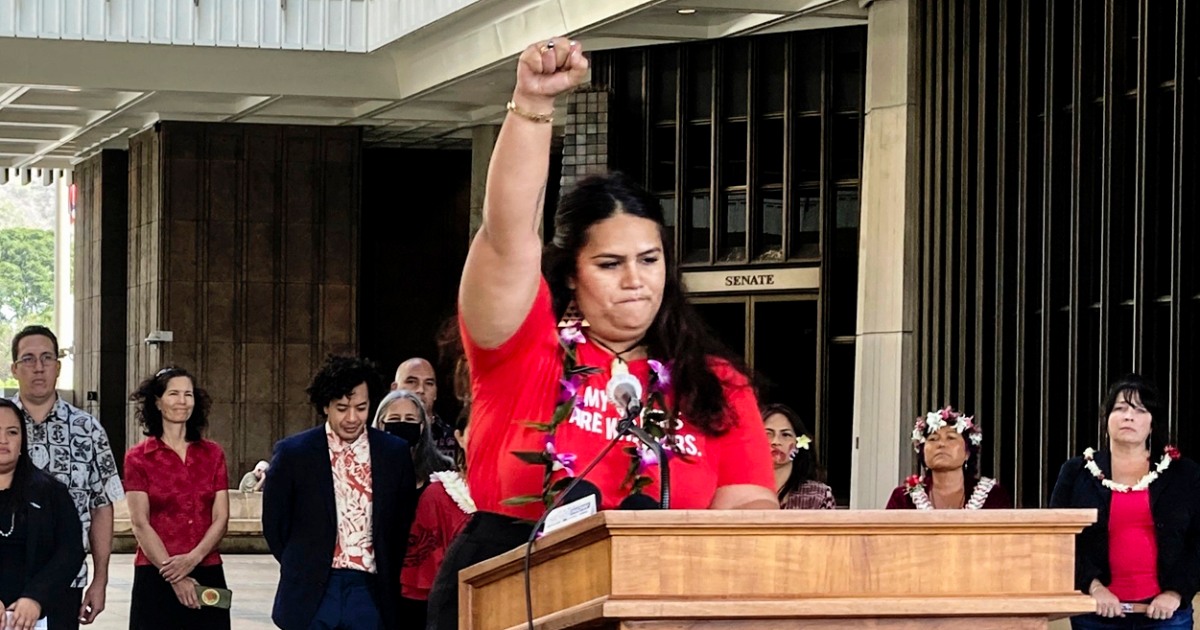Native Hawaiian women and girls experience disproportionate levels of violence, and those inequities have long been insufficiently addressed, new research shows.
In particular, sexual exploitation remains a serious issue, with 43% of sex trafficking cases involving Native Hawaiian girls trafficked in Waikīkī, O‘ahu, according to a report from the Hawaii State Commission on the Status of Women, a statewide government agency.
The report, which examines gender-based violence against the racial group, said that while an estimated 10% of the population of Hawaii identifies as “Native Hawaiian female,” the demographic accounts for more than a quarter of the missing girls in the state over the past decade. But due to the lack of data collection around the group, and insufficient focus on the inequities, the full scope and “true depth” of the violence is likely underestimated, it added.
One particularly significant finding involved the results of Operation Keiki Shield, a multiagency law enforcement operation that launched in 2019, aimed at addressing child sex trafficking in the state. Thirty-eight percent of people arrested through the operation for allegedly soliciting sex online from a 13-year-old were military personnel, according to the report.
“We have over two dozen arrests out of just a handful of operations of active-duty military personnel. … What that also indicates to me is that the predation that involves soldiers preying on children appears to be widespread,” said Khara Jabola-Carolus, co-chair of the Missing and Murdered Native Hawaiian Women and Girls Task Force, the group that released the report. “That should be shocking and alarming and cause for urgency.”
For the report — the first released by the task force, which the Hawaii Legislature established last year — researchers compiled and examined data across state and community agencies in Hawaii on a number of issues including domestic and sexual violence and exploitation. It found that the average profile of a missing child report processed through the state’s Missing Child Center Hawaii is 15 years old, female, Native Hawaiian and missing from O‘ahu. In the past two years, Native Hawaiians made up 84% of the 37 cases publicly reported through MCCH.
“It’s the collision of hatred of Native Hawaiians and hatred of women that just makes it harder for women’s pain and specifically Native Hawaiian women’s pain to register,” Jabola-Carolus said.
In looking at other inequities, the report showed that more than one-third of adults who experience physical violence by an intimate partner in Hawaii are Indigenous, according to 2013 statistics. And 16.5% of all high school students in the state who reported being sexually abused by anyone in the last 12 months were Native Hawaiian females, higher than females of any other racial group, the report said, citing 2019 data.
Military occupation remains an enduring structure of the U.S. colonization of Hawaii, which researchers point to as the basis for the inequities Native Hawaiian women and girls experience today. Hawaii is currently the most densely militarized state in the nation.
The emergence of these disparities can be traced back to interactions between the Native Hawaiian population and Western colonizers from both Britain and the U.S. in the 18th century. The establishment of the whaling industry from these nations, for example, led to businessmen who “came to expect that Kānaka Maoli women would be available to them for sex in exchange for material goods,” the report read, referring to the Indigenous Hawaiian community.
“When a kapu (ban) was placed on prostitution, whalers and businessmen responded violently,” the report said of the 1825 rule. “Historically, Kānaka Maoli women were the first to have their physical mana (spiritual power) controlled through violent, sexualized, patriarchal colonial processes of erasure, sterilization, and birthing.”
Jabola-Carolus said that many in the Indigenous community have long called for the armed forces to leave the islands. Research has shown the negative impact military presence in the area has had on Indigenous communities, ranging from health to economy.
“The occupation of land for military use has resulted in the destruction of the natural environment, the release of dangerous toxins, the destruction of people’s homes, and the displacement of people,” a 2006 report published in Pacific Public Health report read.
In recent years, Jabola-Carolus said, that debate against military presence has grown in part due to devastating events including the leak of 1,100 gallons of toxic fire-suppressing foam from the Navy-operated Red Hill fuel storage facility last month. And with military leases that will expire in the coming years, like that of the Pohakuloa Training Area, which has a lease that ends in 2029, many in the Native Hawaiian community say a reckoning is necessary.
“It’s time for the Department of Defense and Congress to revisit Base Realignment and Closure in Hawaii,” Jabola-Carolus said, referring to the congressionally authorized process the Defense Department has used to reorganize its base structure.
Inequities for Native women and girls are also intertwined with the failures of those with legislative power to recognize these Native Hawaiian issues, the report said. The Violence Against Women Act increased funding for domestic violence and sexual assault services. But services allocated to specifically help Native Hawaiian survivors of gender-based violence were inadvertently excluded from that funding. Legislation introduced by Sen. Mazie Hirono, D-Hawaii, in November would rectify that.
“The State of Hawai‘i’s current legal system was built upon a foundation of Kānaka Maoli erasure that directly sustains the systemic inequities of today,” the report read.
Because of that, data continues to be limited, researchers wrote. And in order to comprehend the full scale and severity of the violence against Native Hawaiian women and girls, better data collection that centers “key experts” — including survivors with lived experience, social workers and therapists — is needed, the report said.
Share your story or advertise with us: Whatsapp: +2347068606071 Email: info@newspotng.com









